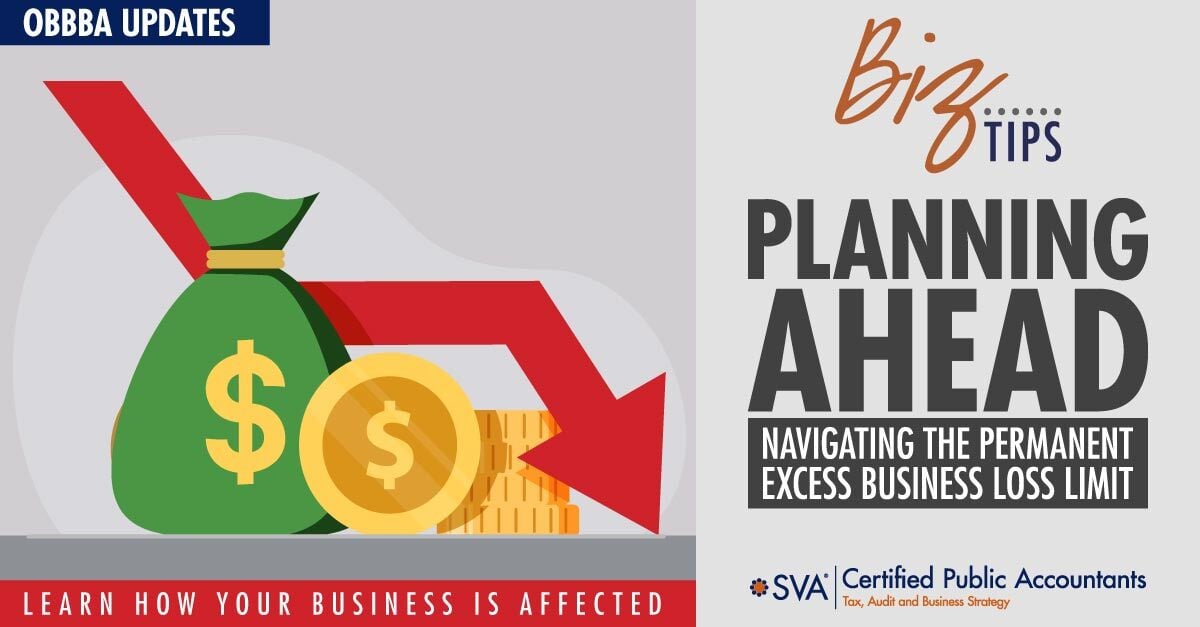When Congress passed OBBBA, one of the changes for business owners was the decision to make the excess business loss limitation permanent.
What was once viewed as a temporary guardrail under the Tax Cuts and Jobs Act is now cemented into law. That means business owners who were counting on this rule to eventually disappear will need to start treating it as part of their long-term tax planning.
What the Rule Was Before
Under the TCJA, noncorporate taxpayers (such as sole proprietors, partners, and S corporation shareholders) were restricted in how much business loss they could use to offset nonbusiness income like wages or investment gains.
- Thresholds mattered. For example, in 2025, the cap was set at $313,000 for single filers and $626,000 for joint filers, adjusted annually for inflation.
- Losses above that amount (called “excess business losses”) were not deductible in the current year.
- Instead, the disallowed portion was carried forward as a net operating loss (NOL), which could offset up to 80% of taxable income in future years.
This rule was set to expire after 2028. Many assumed it was only a temporary break on aggressive loss deductions.
What Has Changed
The OBBBA makes two big adjustments:
| 1. Permanence |
The EBL limitation is now a permanent feature of the tax code. |
| 2. New Twist: "Specified Loss" |
If you had a disallowed loss in one year, that amount (called a specified loss) is added into the next year’s calculations. This makes the formula a bit more restrictive, since past disallowed losses can compound the limitation in future years. |
Other than that, the familiar rules remain: wages, capital gains, and Section 199A deductions are excluded from the calculation; and disallowed amounts still roll forward as NOLs.
How This Affects Business Owners
The permanence of the rule means this is no longer something to wait out. For some, this shift may raise taxable income in years where their businesses show big paper losses, especially in industries like real estate, farming, start-ups, or capital-intensive ventures.
Here are the key effects:
| Less Flexibility With Losses |
You can’t use large business losses to wipe out other forms of income in one shot. |
| Delayed Tax Relief |
Losses above the threshold roll forward as NOLs, so the tax benefit comes later instead of immediately. |
| Greater Planning Required |
Because disallowed losses can pile up as “specified losses,” business owners face a more complex path to managing deductions over time. |
On the flip side, some advisors see a silver lining: this setup may encourage more thoughtful income smoothing and long-term planning, reducing volatility in tax outcomes.
What Business Owners Should Do Now
With permanence comes the need for action. Here are some practical steps:
| 1. Run the Numbers Each Year |
Forecast your EBL exposure with your tax professional. Knowing whether you’ll cross the threshold is the first step in managing it. |
| 2. Timing Strategies |
Look for opportunities to accelerate income or delay losses if it means making better use of the thresholds. |
| 3. Reevaluate Your Entity Choice |
While C-corporations are not subject to these rules, switching entity types is a major decision and should be carefully modeled with an advisor. |
| 4. Leverage Other Deductions |
Use credits, Section 179 expensing, and bonus depreciation to manage taxable income in ways that still provide relief. |
| 5. Track Your Carryforwards |
Keep meticulous records of disallowed losses that roll forward as NOLs—you’ll want to capture every bit of tax benefit in future years. |
| 6. Document Everything |
Especially with real estate or partnership losses, detailed substantiation will be increasingly important if the IRS reviews your filings. |
By making the excess business loss limitation permanent, the OBBBA has effectively locked in a tax rule that was once seen as temporary. For many business owners, that means adjusting expectations and strategies.
The sooner you adapt your planning to this new reality, the better positioned you’ll be to manage your tax outcomes in the years ahead.
© 2025 SVA Certified Public Accountants

.png)